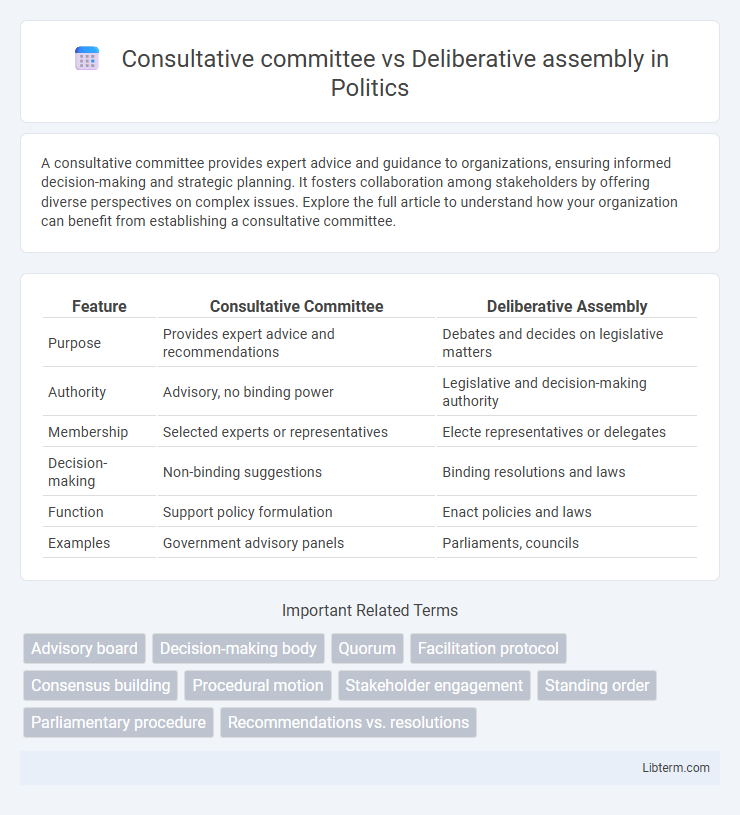A consultative committee provides expert advice and guidance to organizations, ensuring informed decision-making and strategic planning. It fosters collaboration among stakeholders by offering diverse perspectives on complex issues. Explore the full article to understand how your organization can benefit from establishing a consultative committee.
Table of Comparison
| Feature | Consultative Committee | Deliberative Assembly |
|---|---|---|
| Purpose | Provides expert advice and recommendations | Debates and decides on legislative matters |
| Authority | Advisory, no binding power | Legislative and decision-making authority |
| Membership | Selected experts or representatives | Electe representatives or delegates |
| Decision-making | Non-binding suggestions | Binding resolutions and laws |
| Function | Support policy formulation | Enact policies and laws |
| Examples | Government advisory panels | Parliaments, councils |
Introduction: Understanding Consultative Committees and Deliberative Assemblies
Consultative committees serve as advisory bodies that provide expert opinions or recommendations without possessing decision-making authority. Deliberative assemblies consist of members who engage in formal discussion and have the power to make binding decisions on organizational policies or legislation. Both structures facilitate collective input but differ fundamentally in their roles and influence within governance frameworks.
Defining Consultative Committees
Consultative committees are advisory bodies designed to provide expert opinions and recommendations without possessing decision-making authority. They primarily facilitate stakeholder engagement and promote informed discussion on specific topics or policies. Unlike deliberative assemblies, which actively debate and decide on issues, consultative committees focus solely on gathering insights to guide decision-makers.
Defining Deliberative Assemblies
Deliberative assemblies are formal bodies composed of members who gather to discuss, debate, and make decisions on policies or organizational issues through voting processes. Unlike consultative committees, which primarily offer advice without binding authority, deliberative assemblies possess decision-making power and follow structured parliamentary procedures to ensure orderly conduct and fair representation. Key examples include legislative bodies, corporate boards, and organizational general assemblies that operate under established rules such as Robert's Rules of Order.
Key Functions and Objectives
Consultative committees primarily serve an advisory role, providing expert opinions and recommendations to decision-making bodies, facilitating informed policy or organizational choices. Deliberative assemblies focus on the discussion and decision-making process, enabling members to debate issues, propose motions, and vote on resolutions to guide collective action. The key function of consultative committees is to offer specialized insight, whereas deliberative assemblies emphasize participatory governance and consensus-building.
Structural Differences and Composition
A Consultative committee typically consists of a selected group of experts or representatives appointed to provide advice and recommendations without decision-making authority, often smaller in size and structured for focused discussions. In contrast, a Deliberative assembly is a larger, formally constituted body with elected or appointed members empowered to debate, amend, and make binding decisions, reflecting a more complex organizational framework and procedural rules. Structural differences are evident in the roles assigned, where consultative committees serve advisory functions while deliberative assemblies carry legislative or decision-making power.
Decision-Making Processes Compared
Consultative committees primarily function as advisory bodies, providing expert opinions and recommendations without holding formal decision-making power, thereby influencing outcomes indirectly. Deliberative assemblies, in contrast, engage members in open debate and collective decision-making, where proposals are discussed, amended, and voted upon to reach binding resolutions. The decision-making process in deliberative assemblies emphasizes majority rule and transparency, while consultative committees rely on consensus-building and expert consultation to guide decision-makers.
Roles in Governance and Policy Development
Consultative committees provide expert advice and recommendations to decision-makers, influencing governance through specialized input without holding direct legislative power. Deliberative assemblies engage in debates, discussions, and voting processes, holding authority to enact policies and make binding decisions within governance structures. The consultative committee serves as an advisory body, while the deliberative assembly functions as a primary decision-making entity in policy development.
Advantages and Limitations of Each Body
Consultative committees provide specialized expertise and focused advice, enabling informed decision-making but often lack authority to enforce decisions, limiting their impact on final outcomes. Deliberative assemblies promote democratic participation and collective decision-making, fostering transparency and legitimacy, though they can be slower and less efficient due to the need for broad consensus and extensive debate. Each body's effectiveness depends on the context: consultative committees excel in advisory roles requiring expert input, while deliberative assemblies are better for inclusive, representative governance processes.
Use Cases: When to Choose Each Approach
Consultative committees are ideal for specialized input and expert advice in organizational decision-making processes, especially when gathering diverse perspectives without immediate voting power is needed. Deliberative assemblies suit situations requiring formal decision-making and collective voting, such as legislative bodies or corporate boards, where binding resolutions and structured debate are essential. Choosing between them depends on the desired outcome: consultative committees for advisory functions and deliberative assemblies for authoritative governance.
Conclusion: Selecting the Right Forum for Effective Decision-Making
Choosing between a consultative committee and a deliberative assembly depends on the complexity and scope of the decision-making process. Consultative committees excel in gathering expert opinions and focused input, while deliberative assemblies provide broader representation and democratic legitimacy. Effective decision-making is achieved by aligning the forum with the need for specialized advice or inclusive debate.
Consultative committee Infographic

 libterm.com
libterm.com